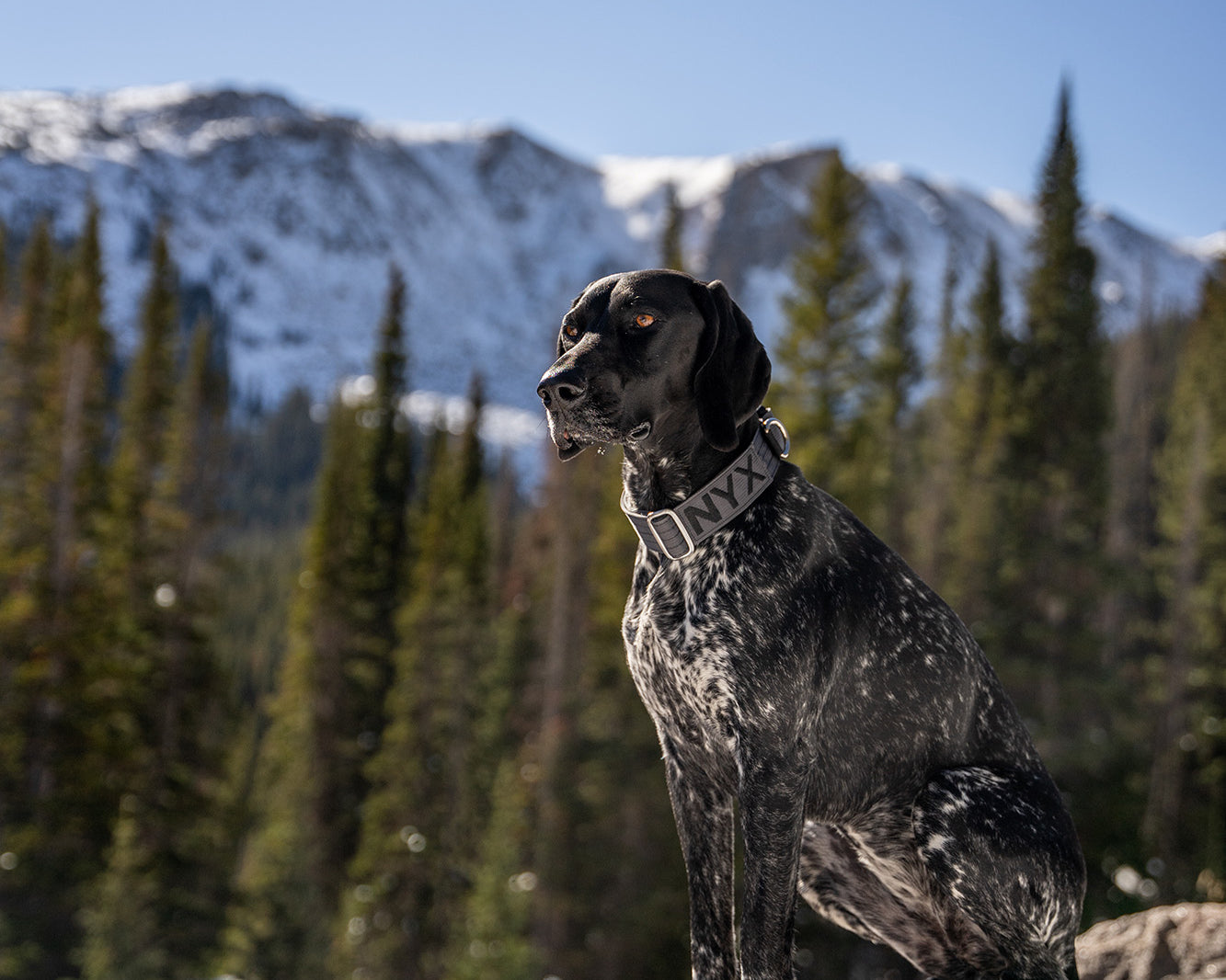We’ve all been there: winter sets in, the temperatures drop, and soon our main source of exercise is plodding to the fridge to get another ham sandwich. Before you know it, the weather warms up, and we realize we should probably sit this bikini season out.
Often, this lapse in activity affects our canine companions; when your fitness suffers, theirs does, too. There are other reasons your pup may find himself obese - a trip to grandma and grandpa’s; recovering from an injury; being rescued from a neglectful situation. At Atlas Pet Company, we know the best adventures are the ones you take with your dog. With our guide to getting your dog back in fighting shape, you’ll be hitting the trails together in no time.

Get outside and hit the trails, together!
“I’m not fat; I just like big bones.”
Some owners don’t even realize that their pup is out of shape. But how can you tell?
First, stand above your dog and look down. Does his waist curve in from his ribs? Look at him from the side. Does his tummy tuck up from his chest? When you rub your hands over his torso, can you feel the definition of his ribs? If the answer to any of these questions is “no,” it’s time to sign your pup up for a fitness program.
Tip: keeping your dog at a healthy weight is more than just a matter of looks. Providing an active lifestyle for your pup reduces the risk of hypertension, arthritis, diabetes, hip dysplasia, and even some forms of cancer. A 2013 study even found that overweight dogs live an average of 10 months less than their healthy-weight counterparts.
But how do you know how much activity your dog is ready for? Honestly assess his age, health, and physiotype before you get started. Some limiting conditions to consider before hitting the pavement:
- Puppies (up to one and a half years) can walk and play, but wait on running for now - young dogs have softer bones and growing joints, and high-impact activity can cause permanent damage.
- Senior pups should start at a slower pace. Keep in mind, even though you might feel young and spry, your elderly dog may need to exercise at a more leisurely clip.
- Cardiovascular issues, like heart disease, will limit your dog’s mobility as the condition progresses. Don’t push these guys too hard.
- Brachycephalic (flat-faced) breeds, like Boston Terriers, pugs, and bulldogs are not natural runners - they can’t get enough air through their nasal passages quickly enough. There are exceptions, but generally, avoid long runs with these pups.
- Arthritis and other joint issues can be limiting, but with time and practice, exercise is actually fantastic - any activity that builds muscle to support the joint is beneficial. These chubby pups will also have to start slowly, be monitored carefully, and consider adding low-impact exercises, like swimming, until their fitness improves.
Even confirmed couch potatoes should naturally love physical activity when it is introduced into their daily routine. If your dog is stubbornly resistant, it may be a sign of a more complex problem. Visit your vet for a physical to rule out any health issues that might be making exercise painful for your pet.
One paw in front of the other.
The most successful fitness plans involve training for a specific, achievable goal, so set your sights on a 5k walk or run, depending on your dog’s capabilities. Choose a date for the event about ten weeks out, or - even better - schedule your training around a local charity event that benefits animal welfare. A good bet is Best Friends Animal Society’s national Strut your Mutt 5k every year in October, which holds events in over a dozen cities.
Any runner with a few races under her belt will tell you: interval training is the most effective way to gradually build fitness. By alternating easy and challenging effort in each workout, you’ll reach a comfortable race pace by the big day.
The plan: designate three days a week to be “training days.” During these thirty-minute sessions, you and your pup should stick to the same workout for the whole week. (Note: your first canine 5k should take around thirty minutes to complete, so we’re setting you up to be comfortable exercising together for a little longer in each session so the race should be a breeze). For the remaining four days of each week, continue your dog’s normal daily activities. This way, you and your pup can build up slowly and include recovery days in his new routine.
|
Week 1 |
Walk 30 minutes - let your pup choose the pace. |
|
Week 2 |
5 minute warm up (easy walk) 1 minute slow jog, followed by 3 minutes of easy walking recovery; repeat 6 times. 3 minute cool down (easy walk) Total: 32 minutes |
|
Week 3 |
5 minute warm up (easy walk) 90 seconds slow jog, followed by 3 minutes of easy walking recovery; repeat 6 times. 3 minute cool down (easy walk) Total: 35 minutes |
|
Week 4 |
5 minute warm up (easy walk) 2 minutes moderate jog, followed by 2 minutes of easy walking recovery; repeat 6 times. 3 minute cool down (easy walk) Total: 32 minutes |
|
Week 5 |
5 minute warm up (easy walk) 2.5 minutes moderate jog, followed by 2 minutes of moderate walking recovery; repeat 6 times. 3 minute cool down (easy walk) Total: 35 minutes |
|
Week 6 |
5 minute warm up (easy walk) 3 minutes moderate jog, followed by 90 seconds of moderate walking recovery; repeat 6 times. 3 minute cool down (easy walk) Total: 35 minutes |
|
Week 7 |
5 minute warm up (easy walk) 3.5 minutes moderate jog, followed by 1 minute of easy walking recovery; repeat 6 times. 3 minute cool down (easy walk) Total: 34 minutes |
|
Week 8 |
5 minute warm up (easy walk) 4 minutes moderate jog, followed by 1 minute of moderate walking recovery; repeat 6 times. 3 minute cool down (easy walk) Total: 38 minutes |
|
Week 9 |
5 minute warm up (easy walk) 5 minutes moderate jog, followed by 30 seconds easy walking recovery; repeat 6 times. 3 minute cool down (easy walk) Total: 40 minutes |
|
Week 10 |
5 minute warm up (easy walk) 27 minutes moderate jogging 3 minute cool down (easy walk) Total: 35 minutes |
|
Week 11 |
RACE DAY! |
Athletic support.
Of course, your dog’s path to optimal health requires more than just a fancy training plan. There are plenty of things you can do to ensure your pup’s new career as a fitness model goes off without a hitch.
Supplements can be very effective in supporting your dog’s newly active lifestyle. No doubt you’ve felt sore after completing a challenging workout; the same aches and pains affect canines, too.
To prep your your pup’s joints for running, consider adding a glucosamine, chondroitin, and MSM chew to his treat rotation, particularly if he’s on the senior side. These compounds help “lube” your dog’s joints to work more smoothly - a huge bonus as he gets older.
For post-workout pain, try a curcumin supplement specifically formulated for pups. Many clinical studies are now pointing to the eastern spice as an effective treatment for inflammation. Bonus: trials are being held to explore curcumin’s possible role in reducing cancer rates.
Tip: what gear should your pup sport while running? Check out our guide to running with dogs for advice on choosing a leash, harness, and collar.
Don’t think we’ll ignore the elephant-sized bowl of kibble in the room. If you’re overfeeding your pup, you’re giving him a steep uphill battle to reach his 5k goal. There are plenty of excellent feeding guidelines from reputable sources on the web, but the best (and most customized) advice will come from your vet. Visit your dog’s doc to overhaul his diet plan to help kickstart his race to fitness.
 30 minutes a day can go a long way for you and your pup!
30 minutes a day can go a long way for you and your pup!
Enjoy the runner’s high.
We here at Atlas engineer products that enable a lifetime of adventure with your pup. Running your first 5k is an awesome “gateway drug” to a world of excitement and joy you can share with your dog; we hope you get addicted!





























